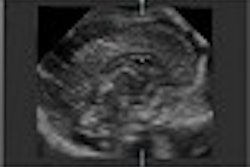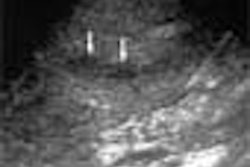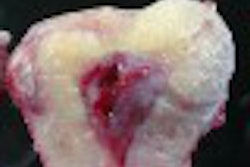(Ultrasound Review) Differentiating total versus near total occlusion of the internal carotid artery (ICA) is a familiar diagnostic dilemma. Patients with near total occlusion remain at high risk for embolic stroke and are surgically treated, while those with an occluded ICA are at minimal risk for embolic phenomena and are treated medically for hypoperfusion, according to researchers at the West Los Angeles Veterans Administration Medical Center in California.
The purpose of this prospective study was to evaluate ultrasonography and magnetic resonance angiography (MRA) in differentiating these two stages of atherosclerosis. The results were published in the November issue of Radiology.
Two hundred and seventy-four consecutive patients underwent catheter angiography and MRA of the extra- and intracranial carotid arteries and duplex ultrasound of the extracranial carotid arteries. Carotid endarterectomy was performed when Doppler ultrasound showed a peak systolic velocity (PSV) greater than 250 cm/sec and an ICA/CCA PSV of 4.0. Previous research by this group determined that these criteria indicated a greater than 70% stenosis. Thirty-seven patients were shown to have a total occlusion and there were 21 near total occlusions.
"Ultrasound depicted all total occlusions; MRA depicted 34 (92%). Ultrasound depicted 18 of 21 (86%) near occlusions; MRA depicted all," they wrote.
Ultrasound was useful in differentiating between patients with focal stenosis versus those with diffuse disease, but MRA was not capable of differentiating these two disease types. There were three patients with distal ICA occlusion that were correctly diagnosed with ultrasound. When duplex waveforms in the ICA are low-velocity with high-resistance this suggests severe disease in the more distal portion of the ICA, they said.
"Assuming ultrasound is the initial imaging examination, when occlusion is diagnosed, MRA can depict it. If occlusion is confirmed, no further imaging is necessary," they said. In this study there were eight patients (13.7%) with diffuse non-focal disease and according to the authors, these patients are best managed with conventional angiography.
"Imaging of the internal carotid artery: the dilemma of total versus near total occlusion"S M El-Saden
Dept of Radiology, West Los Angeles Veterans Administration Medical Center, Los Angeles, CA
Radiology 2001(November); 221:301-308
By Ultrasound Review
January 8, 2002
Copyright © 2002 AuntMinnie.com



















